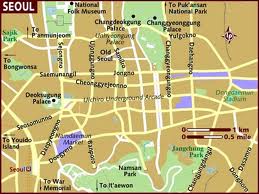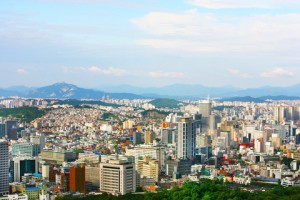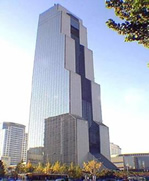
[Updated Oct 2020]A guide to serviced offices and office space for rent in Seoul as well as general information that may be useful if you are thinking of renting office space in the city.
For further offices information or to search office space for rent in Seoul just click. Or contact us for any other office space query.
History & Geography
The capital of South Korea is one of the largest cities in the world and has a history stretching back more than 2,000 years. Located in the northwest of the country, Seoul is bisected by the Han River and is looked down upon by eight mountains on its border. The Seoul area first gained prominence when it became the capital of the Baekje kingdom in approximately 18 BC. The next few hundred years saw the city change hands a number of times, due to its strategic importance. It was believed that the ruler who controlled the Han Valley would also hold sway of the whole Korean Peninsula. In 1104 the importance of Seoul was cemented by King Sukjong of the Goryeo who built an elaborate palace in the city. During this time Seoul expanded significantly and was dubbed Namgyeong, or ‘Southern Capital’. It was in the late 19th century that Seoul finally opened its gates to outsiders after centuries of isolation. Quickly the city became one of the most modern in Asia, with electricity, trolley cars, running water, telephones and a telegraph system. In 1910 Seoul was annexed by imperial Japan, a rule which lasted until 1945 and Japan’s defeat in WWII. After the war Republic of Korean was declared and Seoul immediately was chosen as the capital. In 1950 the Korean War broke out and in the subsequent years, Seoul changed hands between the UN-backed South Korean forces and China-backed North Koreans a total of four times. Not only were large parts of the city destroyed in the fighting, but hordes of refugees from North Korea streamed into Seoul, sending its population to 2.5 million people. After the war, extensive reconstruction was carried out on the city and living standards improved considerably. High rise office buildings and apartments were built in great numbers during a construction boom in the 1960s and 70s and the Seoul metropolitan area became the third largest in the world. Today 24 percent of the South Korean population live in the city and Seoul is one of the world’s richest and most expensive cities.
Economy
While South Korea accounts for a mere 0.6 of South Korea’s landmass, it punches far above its weight economically, accounting for more than 21 percent of the country’s GDP. A host of major South Korean companies have their headquarters in Seoul, including Samsung, LG, Hyundai, Kia and SK. The automobile, construction, mining and high tech industries make up the most important, but by no means only parts of Seoul’s economy. Furthermore many financial services companies and banks have branches in the city, among them HSBC, Barclays, UBS. Credit Suisse, Deutsche Bank, UniCredit and Goldman Sachs. In effect, Seoul is one of the most important financial and commercial hubs in the region. Seoul is also a major retail centre, boasting the largest market in South Korea, the Dongdaemun Market. Of late the city has also had a burgeoning tourism industry, with most visitors to South Korea spending some or most of their time in the city.
 Tourism
Tourism
Every year South Korea sees almost seven million visitors, most of whom stay in or at least pass through Seoul. While South Korea does have a fair amount of attractions outside the city such as the Seorak-san National Park and Jeju Island, Seoul is the jewel in the crown. Recently visitors from Asia have increased substantially with tourists from China, Hong Kong, Southeast Asia and Taiwan. The Korean wave, a term used to refer to the recent spread of South Korean culture, has contributed significantly to this trend. Seoul is home to a myriad of museums, parks, historical architecture and vibrant shopping districts. Gangnam-gu is the city’s primary shopping district and is home to the famous COEX Mall and the Apgujeong area which features many high-end boutiques and restaurants. Itaewon district is also very popular with tourists and US armed forces personnel due to its myriad of restaurants serving international food and its vibrant and varied nightlife. Itaewon is also home to the famous Yongsan Electronics Market, where items can be had from 20 to 50 percent less than usual retail price. Many tourists visiting Seoul coincide their visits with the Hi! Seoul Festival, which happens four times a year and features parades, cultural demonstrations and food and drink stalls. Korean cuisine is largely based on rice, vegetables and meats. Korean food features many side dishes like Kimchi, fermented vegetables and rice. Perhaps the most famous dish is Bibimbap, white rice topped with vegetables and chilli pepper paste, usually served with a raw or fried egg and sliced meat.
Transportation
Seoul boasts one of the most efficient and advanced transportation infrastructures in the world and one that is constantly expanding. Most of the city’s residents travel on the subway, which has nine major lines covering more than 250 kilometres. Seoul also has an extensive bus system, covering the city in its entirety, as well as long-distance bus service to other Korean cities. The KTX high-speed train also links Seoul to other major Korean cities. The train travels at speeds of over 180 miles per hour. Seoul is served by two international airports, Gimpo and Incheon. Incheon is the primary airport serving international flights, except for flights to Tokyo International Airport, which are served by Gimpo.
 Office space for rent in Seoul
Office space for rent in Seoul
Seoul has several primary business districts including Gangnam, Yeido, and of course the Central Business District. Currently, the average vacancy rate across the city is approximately 6 percent, and recently the rent for Grade A office space in the CBD jumped by almost two percent. However, the Seoul office market remains very much a tenant’s market, with most office buildings providing incentives such as a month rent-free every year. New supply is being built across the city and this is expected to have a downward effect on rents and cause the vacancy rent to rise.
We carry out a free office space search and our advisory and acquisition services are also free, always. Our Seoul office space brokers and agents are globally regulated by the Royal Institution of Chartered Surveyors (RICS) ensuring the highest standards of commercial property advice and service at all times. We look forward to helping you find the best office space for rent for your business.

The Office Providers are Regulated by the Royal Institution of Chartered Surveyors (RICS)